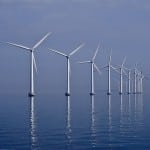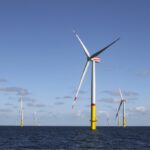The Biden administration’s push to accelerate offshore wind deployment formally expanded into the Gulf of Mexico as the Bureau of Ocean Energy Management (BOEM) on July 20 unveiled two draft wind energy areas (WEAs) off the coast of Galveston, Texas, and Lake Charles, Louisiana. The sites represent a “small subset” of its original 30-million Gulf of Mexico call area, it said.
Combined, the draft WEAs cover 734,668 acres, and BOEM suggests they have the potential to power 3.1 million homes. The Department of Interior (DOI) agency that manages development of U.S. Outer Continental Shelf energy and mineral resources did not provide a power capacity estimation. However, the Electric Reliability Council of Texas (ERCOT) estimates that 1 MW of electricity can power about 200 Texas homes during periods of peak demand. While unconfirmed by BOEM, that suggests the draft WEAs could host a combined 15.5 GW of capacity.
The first draft WEA spans 546,645 acres about 24 nautical miles (nm) off the coast of Galveston, Texas. The second draft WEA, an area of review of about 188,023 acres is located approximately 56 nm off the coast of Lake Charles, Louisiana.

Part of a 30-Million Acre Gulf of Mexico Call Area
BOEM on Wednesday said it identified the sites following its October 2021 unveiling of the original 30-million acre Gulf of Mexico Call Area. “The draft WEAs were reduced to avoid potential impacts on other ocean uses and resources, such as commercial and recreational fishing, maritime navigation, military activities, marine protected species, avian species, and existing infrastructure,” it noted.

BOEM’s process to identify the sites has been relatively quick. The agency issued a request for interest in June 2021 to gauge interest in obtaining commercial wind leases in the Gulf of Mexico Outer Continental Shelf (OCS). The RFI was followed by a call for information and nominations issued in November 2021. “Comments received from the RFI and the call are used to inform the Area Identification (Area ID) process. The Area ID process is a required step under the renewable energy competitive leasing process and is used to identify Wind Energy areas (WEAs) to be considered for leasing,” it said.
The agency has solicited public comment on the draft WEAs. The comment period will close on Aug. 22, 2022. “BOEM will continue to study these areas and consider input from other government agencies, industry, the fishing community and the general public, and will use this information to finalize the WEAs and publish an Area ID memorandum,” it said.
In addition to the draft WEAs, BOEM on Wednesday issued a draft environmental assessment (EA) covering the entire call area “to consider the potential impacts from site characterization (e.g., marine mammal surveys) and site assessment (e.g., installation of meteorological buoys) activities expected to take place following lease issuance.” The EA analysis is expected to inform potential lease stipulations related to environmental impacts associated with offshore wind leasing activities. Public comments on the draft EA will also be accepted for 30 days beginning July 20, 2022.
Offshore Wind Lease Sales Picking Up Pace
BOEM’s recent actions respond to the Biden-Harris administration’s goal to install 30 GW of offshore wind by 2030. So far, only two commercial projects have BOEM’s green light: the 800-MW Vineyard Wind 1 project offshore Massachusetts and the 130-MW South Fork Wind project offshore New York.
However, the agency has made notable progress on planned lease sales. On Feb. 23, BOEM held an offshore wind auction for six lease areas in the New York Bight. The lease sale drew competitive winning bids from six companies totaling approximately $4.37 billion, revenue that goes to the U.S. Treasury. Companies that executed leases from the Bight auction include Ocean Winds, Attentive Energy, Community Offshore Wind, Atlantic Shores Offshore Wind, Invenergy Wind Offshore, and Vineyard Mid-Atlantic. BOEM then completed a second lease sale on May 11, 2022, for two areas in Carolina Long Bay. That lease sale drew competitive winning bids from two companies—TotalEnergies Renewables and Duke Energy Renewables Wind—totaling approximately $315 million.
The agency now plans to “potentially” hold up five additional offshore lease sales by 2025. Along with the Gulf of Mexico, areas include Northern and Central California, the Central Atlantic, Oregon, and the Gulf of Maine. BOEM also plans to complete the review of at least 16 plans to construct and operate commercial offshore wind energy facilities by 2025, representing more than 22 GW of new offshore wind power for the U.S., it said.

American Clean Power, a trade group representing the renewables industry, has reported that U.S. states have established 45 GW of offshore wind procurement targets. State-led efforts were buoyed in June by the White House’s effort to establish a federal-state offshore wind implementation partnership, which launched as a forum between 11 East Coast governors and administration officials.
Collectively, New York and New Jersey have set the nation’s largest regional offshore wind target of installing more than 16 GW of offshore wind by 2035. Earlier last week, BOEM published a notice of intent (NOI) to prepare a programmatic environmental review to analyze the potential impacts of wind energy development activities in the New York Bight and New Jersey.
The effort will mark the first time BOEM will conduct a regional analysis containing multiple lease areas for offshore renewable energy. “This new regional approach is an evolution of our process to help ensure timely decisions that advance offshore wind while protecting the ocean environment and marine life,” said BOEM Director Amanda Lefton.
—Sonal Patel is a POWER senior associate editor (@sonalcpatel, @POWERmagazine).










